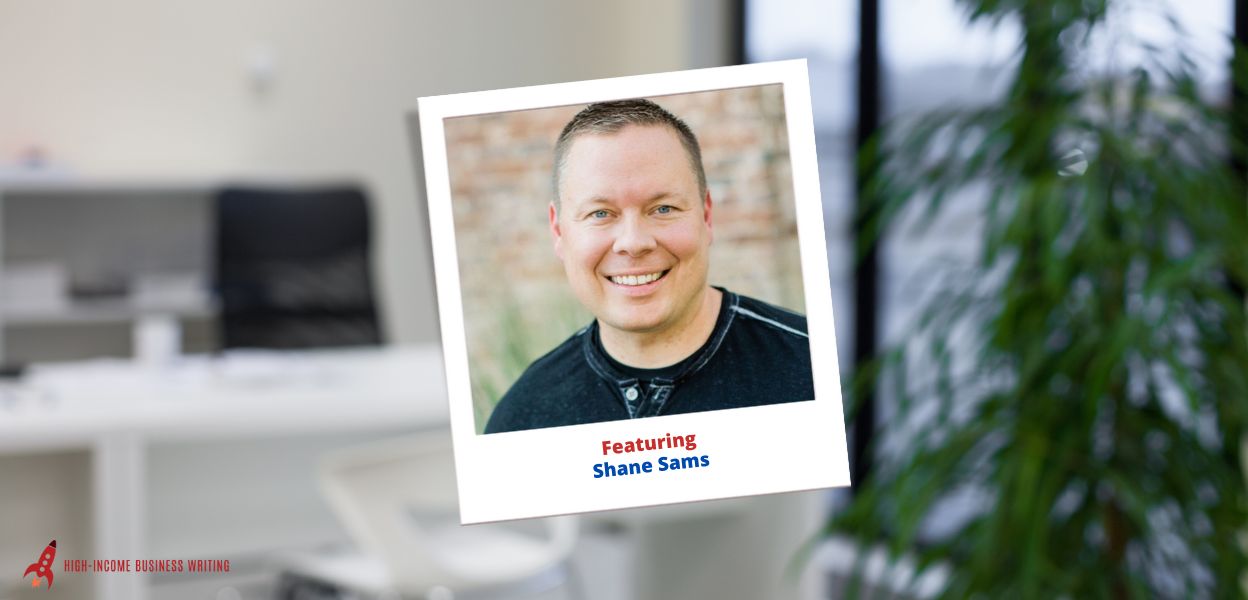One of the biggest advantages of being a self-employed creative professional is that you generally have much more freedom and flexibility than you do when working for someone else as an employee.
You can choose whom you want to work with, what projects you take on, when you work and how much of a workload you take on at any given time.
Of course, it doesn’t always work that way. Sometimes we have to take on less-than-ideal projects and clients to keep the lights on. Sometimes clients we thought were going to be wonderful to work with end up being terrible.
There are many things you can do to minimize these situations. We discuss many of them in this podcast and in my newsletter.
But there’s one other strategy that can help, and it’s one that most writers and copywriters don’t pursue.
I’m talking about developing passive income streams that complement your core freelance business.
I started developing multiple income streams in early 2008, about two years after quitting my day job and going completely on my own. It started as a way to diversify my income, and in my case it involved selling digital products. And over the next nine years those passive income streams turned into my core business.
So as you can imagine, I’m a big believer in developing passive income. Not necessarily because it could turn into your main thing … but because of how it can add diversity to your income and reduce your overall business risk. Having steady revenue outside of my client work coming in the door every month was very reassuring.
Think about this: how would your decisions about what clients or opportunities to accept be different if you had a steady stream of passive income coming in every month?
I bet they’d be very different!
That’s what we’re talking about today. My guest is Shane Sams, a former high school teacher and football coach who, along with his wife, has created a passive income empire that enabled them both to quit their day jobs many years ago.
In this conversation, Shane talks about how he and his wife were able to build and grow a very reliable income stream in the span of a couple of years. He talks about all the mistakes they made and how they learned from them. And he details the best model for building a reliable income stream.
I found this to be a fascinating discussion, and I urge you to give it a listen, even if you’re very skeptical about this subject.
In fact, on that note I have one quick comment. When Shane’s team approached me about coming on the show, I was very skeptical myself. There’s a lot of nonsense going on in the “make money online” industry. Lots of get-rich-quick claims. Tons of scams. Too many bad people who don’t really do what they’re teaching.
I made it abundantly clear that I wanted to portray a very accurate and realistic picture of what passive income is about, what it takes to succeed, and the hard work required to get it off the ground.
Shane really came through. As you’ll see, he’s very open about all his mistakes and failures. And he’ll be the first one to tell you that this takes a lot of work. The income may be passive down the line, but there’s nothing passive about the work you have to put in up front for months.
The notes that follow are a very basic, unedited summary of the show. There’s a lot more detail in the audio version. You can listen to the show using the audio player below. Or you can subscribe on Apple Podcasts, Spotify, Stitcher, Google Podcasts, Amazon Music or wherever you listen to podcasts.


High-Income Business Writing with Ed Gandia
#322: A Realistic Way to Develop Passive Income Streams as a Writer (with Shane Sams)
Key Topics and Bullets:
- Shane discusses three categories of ideas: harnessed, learned, and lived through.
- Examples of each category, emphasizing the importance of choosing one resonating idea and trusting the process.
- Examples of successful niche businesses and the importance of targeting specific audiences for increased sales.
- Shane’s experience in creating successful membership communities and the key components for their success.
- Various examples of profitable membership communities, emphasizing the willingness of people to pay for various topics.
- Emphasis on brainstorming passions and hobbies to identify potential membership community topics.
- Shane’s success story of creating online lesson plans and quitting his teaching job.
- Establishment of Flip Lifestyle to teach others how to start successful memberships.
- The importance of starting with the product, understanding the audience, and nurturing and converting viewers into subscribers.
- Examples of attracting an audience through platforms like podcasts, blogs, and YouTube channels.
- Advice on prioritizing goals, mindset, and creating multiple streams of income with limited time.
- Insight into Shane’s personal journey, including various entrepreneurial attempts.
Timestamp Overview:
05:33 Shane– And then I started another website. I was like, well, what did Pat do? Pat took something he already knew about. He didn’t just try to make up something from scratch. So I had this other website. It was called US history worksheets.com, and it was this spammy 1990’s-looking website. This was about 2012, and, like, I had a well, I was trying to give away free worksheets to history teachers or social studies teachers, but I surrounded it with all those little, like, ads that would say, like, “download”,” look at this”, and they’re like flashing. I was hoping that someone would click the wrong link and I would get some commissions off of it.
08:27 Shane– It’s called US History Teachers .com, and then I also launched a website selling playbooks to football coaches. So we were testing our methods in multiple domains. And then, in September, actually, 2013, we were able to quit our jobs because we were making more in a month than we were making in a year as teachers, so we said, we’re out of here. And what got me to where I am now with Flip Lifestyle, which is my brand where I teach other people how to start memberships like this, is a friend of ours just asked us, hey. What are you doing? That looks amazing. Like, do you think I could do that? Do you think I could have a second stream of income or maybe even quit my job? And we’re like, sure. Her name was Lindsey, and we just showed her how to make money online. And, wouldn’t you know it? A few months later, she quit her job, just using the stuff we had taught her.
11:41 Shane– They’re looking for a solution to a problem. So if you’ve got a solution to any problem that you’ve solved for yourself, you can help somebody else who’s in that situation get out of it. So they’re gonna look for that. But when they find that, they’re gonna be able to either consume that or they’re gonna get bored and not consume it, and then they’re gonna quit your membership. So what we do is we give them access to each other through these group calls. So now you have this synergy built where you’ve got hundreds, dozens of people doing things together in these group environments, and that’s really what keeps on paying in the membership month after month and year after year is access to their friends, access to their community, access to the leader or the leaders’ lieutenants so that they can get the answers that they need. So it’s that human connection that really sets a membership apart from other, like, digital products or even a coaching product. And I really believe this.
13:30 Shane– But all these writers that were buying Scrivener had a problem. They were missing their deadlines, they weren’t hitting their word counts, they were doing and he I was like, why did they miss their word counts? And he said, well, because they’re all alone. They’re just sitting around by themselves on Saturday night trying to finish up some writing, and they’re bored and they’re procrastinating and they’re just not doing it. And I said, well, why don’t we put them together? We’ll do writing times. You can get on Zoom every Monday, Tuesday, Wednesday, Thursday, Friday at 12 o’clock noon, we’re all gonna meet and we’re gonna write together. And then I had Joe order a, like, a giant hourglass and when he got there, he was like, “Hey, everybody. Welcome to the Unchained Writer community. Here’s what I want you to do…”
18:51 Ed– Are there topics because you mentioned 50 as a kind of a price point. I know it’s arbitrary. But are there topics that, you know, nobody’s gonna pay 50 a month for, versus some that…?
Shane- I have not seen many that people won’t pay $50 a month for unless it was specific to the business model. Like, we have a friend named Erin Chase, who built a membership about, it’s called $5 dinners and what she tells you for. So for $5 a month, you get, like, it’s like a grocery list and recipes to make a $5 dinner for a family of 5. Right. So she has this gimmick that she’s kind of going with, you know, but she’s got like, she’s making $25,000 a month on that. Like she’s got like the hundreds and hundreds of people paying her $5. Right. So we’re looking at the scale.
22:50 Shane- So once you see all your ideas on the table, it is just deciding which 1 you wanna do and then following the process to see if it works.
Ed– So just pick 1. Basically, one that is just really calling to you.
Shane– Because you don’t know. Because you don’t, there’s no way that you can. We have some research tools. We have a method that we use to research things where we can kinda see if it’s making money for other people, which is a good thing. You want there to be competition because if there’s a market already, you can just go get your piece of the pie, but you really never know, like, like what’s going to work.
23:30 Shane– Let’s see what happens. And she goes out and, man, she built this into she has over 400 people paying her $50 a month. She’s making $20,000 a month just on that side of her business. It got so big that not everybody wanted to raise the sheep themselves and share them, so she actually started providing the wool in a subscription box on top of the membership for her students. She would send them kits. She got so many clients. She ran out of sheep to share, so she had to go to her neighbor and get another sheep farmer to help her fulfill all of this subscription box. And this thing got so big, right, this sheep shearing business that she and her partner bought a school, like an old elementary school, and they turned it into, like, the cafeteria and stuff into an event center, and they turned all the little rooms into bed and breakfast.
29:30 Ed– So let’s talk a little bit about building an audience, right? So we’ve kind of skirted the issue a little bit, but you talked about a podcast, you talked about other ways of finding do you build an audience first And then you create the membership and the products. Do you do that along the way? What is the model? Because we know that we have the idea, but how do we attract an audience who can then be viable customers for us.
Shane– A So we wanna know what the product is first. We wanna make that, keep it simple, and then we start building an audience specifically targeted for that exact product that is going to emerge from what we’ve already planned. Because if you do it the other way, if you build a big audience. I’ve seen people do this. Like, we’ve got a student. Her name’s Nicole, and she wanted to help nurses pass nursing school. So she wanted to start a membership for nursing students. Right? Well, she went out and created an audience. She’s on TikTok. She’s doing dances. She’s all the nurses are following her, and, you know, she built this big email list of a bunch of nurses. Here’s the problem though. Her product was much it was in her product was for people who were going back to school as a 2nd career nurse, like a nontraditional type of student. Right? It was someone who could go out and get the job, and they’re trying to change their family’s future with a new career and all this other stuff. It wasn’t for the freaked-out 22-year-old who was just trying to get an a. Right? That’s not what it was for.
31:25 Ed– What are some, you know, I’m gonna teach guitar lessons and I know my avatar is people in their 50’s, men in their 50s and 60s who always put this off. How do I find these people and what kind of content do I create on a regular basis for free to make sure I keep attracting that audience?
Shane– I really believe there’s only, like, 3 ways to build an audience, and that’s either with a podcast, a blog, or a YouTube channel right now. I mean, I think you’ve got to either create audio video or text. I’m not sure about blogging as much anymore. I think that’s becoming harder. Podcasting and YouTube is really a great place to build your audience and go out and build some content and make it happen because you can truly like, right now, we’re having a conversation, like, you can see expertise on both of us, we’re talking, we’re doing the different things, it’s, it’s intimate, like, we’re probably in the car with somebody right now. We might be in the bathroom with somebody right now listening to this.
33:47 Shane– Kevin teaches whole songs on YouTube. Like, he’ll say, hey, you know, come learn. I don’t know if this isn’t one of, like Guns N’ Roses, I’ll put Guns N’ Roses, patience, and he’ll teach you how to play that, right? But then he might say, I’ll teach you how to do the whole album inside my membership, you know? I would do it with US history teachers, I would always, my content was giving away, like, the 1st day of a unit because it takes about 2 weeks to teach, like, the Civil War. And then I know they’re gonna take that, and they’re gonna have such a good time that 1st day. They’re gonna be like, oh, more of this, and then I’ll have more inside. I don’t get too caught up on what content to give away for free mainly because anything you could ever give away content for free is out there already. Any content on the Internet somewhere.
38:58 Ed– Let’s talk a little bit about one of the challenges that many people in my audience face, which is time constraints, right? They’re running a business, they have 4 or 5 clients, many of them are book solid from, you know, a big chunk of the month. And you know, I get it. I wanna do this, but you know, my guaranteed income stream has to take precedence and priority. How do I turn this into a real priority? How do I build this thing? How do I get this thing off the ground? And then we can talk a little bit about some of the technicalities later, but that’s a big obstacle.
Shane– I would call people out because I do this all the time. I I’ve a, I teach, live workshops and I have this little activity where I make people, like we give them this grid and it has 168 squares on it. Right? So we have 168 squares to represent 168 hours in a week. And then we go through and we put, like, the nonnegotiables on it. Right? We put, like, sleep, Work with boundaries. I have them look at their screen time on their phone to see how much they’ve been scrolling on TikTok. Right? And we go through this and we look at all the non-negotiables, family time, stuff like that. Nothing entertainment, nothing fun like that, and we always find a couple white squares at the end of it. We’re shading them in, and by the end of it, there’s like 5 white squares that aren’t taken. Like, what are you doing with that 5 hours? That is plenty of time a week, hour a day, or maybe blocking off 5 hours on a Saturday morning to go out and build, you know, some kind of online business.
41:33 Shane– So getting smart with your time, using the technology to batch things and really being really efficient with those few hours you got. That’s the only way to do it. There’s only 2 ways to be a successful online entrepreneur. You roll up your sleeves and you open your wallet. That’s it.
43:50 Ed– I’m assuming that you could start with a very low budget, scrappy. You don’t need it when you’re starting out and you have a zero audience. You don’t need to do Facebook ads. You don’t need to do paid ads in order to kinda feed the funnel initially. You could just start with free content, YouTube, a podcast, for example, and just trust that the right people will find you.
Shane– I would definitely say you need a home base. Like we use Kajabi for our website. That’s what the software we use. It can host your products. They can do all these things. Like I do think you need to host your own little place. So something you’re gonna spend, I don’t know, 150 to $250 a month on different software, that you need to kinda do things efficiently, and then you wanna then you wanna take that stuff and also also put it on YouTube to pull back to that website or back to that sales funnel.
46:31Ed– So what would you suggest if you net it out? Somebody wants to start. What would you tell them to do?
Shane– You always start with yourself, and that means you’ve gotta find your god given gifts and ideas. You gotta get that out there and into the world. So a You gotta figure out what do you have to offer the world? What problems can you solve? So we do have a special training that, little activity I told you about earlier. I’ve got a full Anning where I teach it in my workshops. If you go, let’s see. I think it’s flippedlifestyle.com/ed, ed, not e d d.
Learn more about Shane here:
Flipped Lifestyle
LinkedIn
By the way… whenever you’re ready, here are 3 ways I can help you grow your freelance business:
- Grab a free copy of my book.
It’s called Earn More in Less Time: The Proven Mindset, Strategies and Actions to Prosper as a Freelance Writer. The title says it all. 😉 — Click Here - Join my implementation program and be a case study.
I’m putting together a new implementation group this month. If you’re earning $5k+/month (or the part-time equivalent) from your freelance business … and you’d like to grow your income quickly with better clients … just email me at ed@b2blauncher.com
- Work with me privately.
If you’re a 6-figure writer who’s trying to earn more in less time, with less stress, I might be able to help you get there faster than you think. Just email me at ed@b2blauncher.com and put “Breakthrough” in the subject line, and I’ll get back to you with more details.






